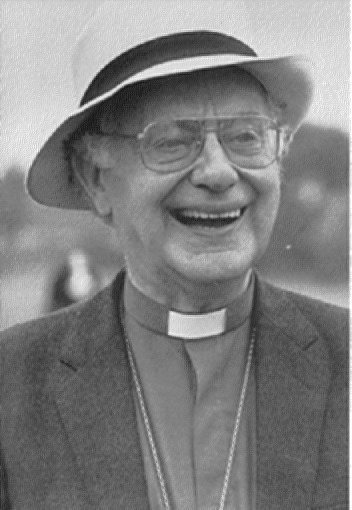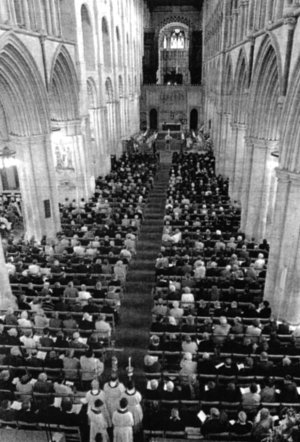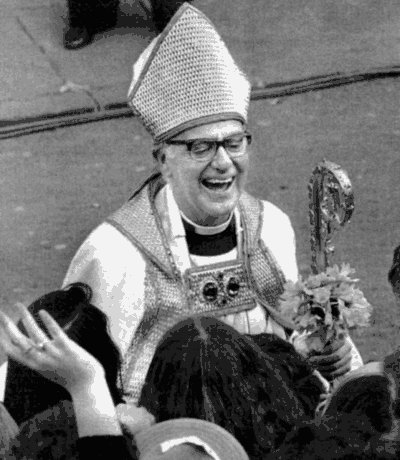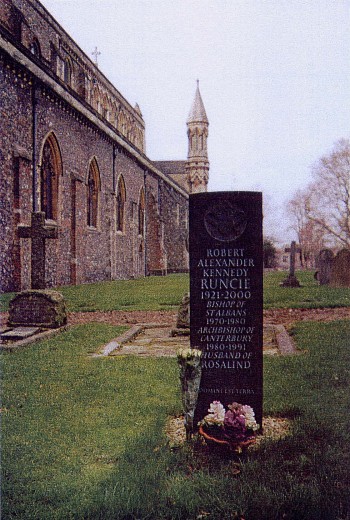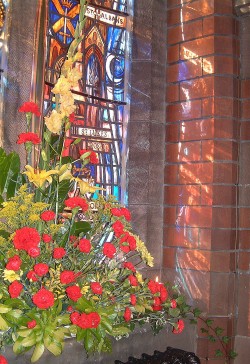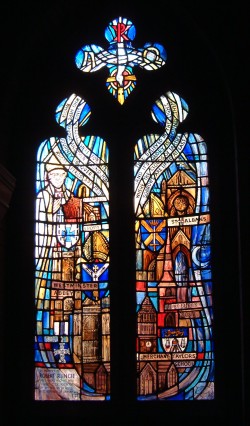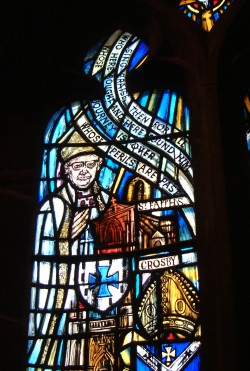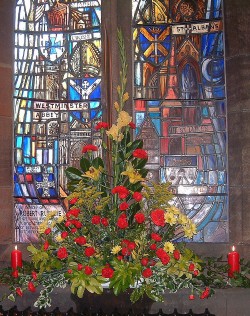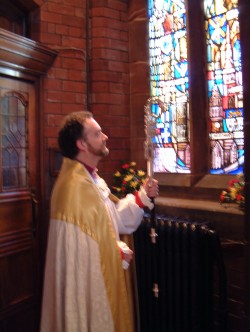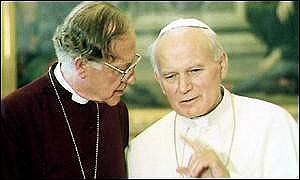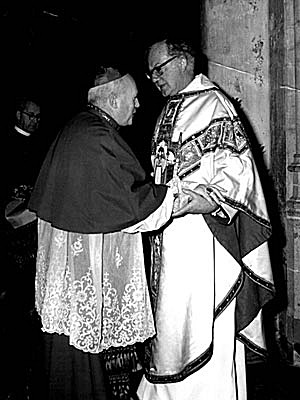Page
Updates:
March 15th, 2005
The first update is a full and
perceptive obituary notice dating from 2000. The
second, a short poem, is an impression of Robert Runcie's
enthronement
in Canterbury Cathedral in 1980, scenes from which feature
on the DVD 'Lord
Runcie Remembered' referred to in the previous update.
Robert
Runcie, who has died aged 78, might
prove to have been
the last of the patrician archbishops of Canterbury. Tall and
elegant,
urbane and witty, he had the sort of charisma - not always
evident on television
- that made everyone he spoke to feel special. People loved
him for it.
Yet there was always that subtle formality that set him apart
in church
circles from the casual familiarity with which Christian names
are almost
universally used. Old friends called him Bob, newer friends
called him
Robert; but those who had no right rarely presumed to refer to
him as anything
but "the archbishop".
He was a workaholic perfectionist,
demanding impossibly
high standards of himself and of his staff. Only his most
intimate friends
knew the true depth of the spiritual faith and toughness which
sustained
him through punishing schedules of work, public engagement and
overseas
travel. The vulnerability was there, but the toughness also
enabled him
to withstand the constant attacks from the tabloid and
rightwing press
that were mounted on him and his family throughout the middle
years of
his time at Lambeth Palace.
For a short honeymoon period, it had
delighted
the media that this pig-keeping, ex-tank commander archbishop
should officiate
at a royal wedding, welcome the Pope to Canterbury, and deploy
Terry Waite
to rescue hostages. But the dramatic change came when he
preached penitence
and reconciliation at the service of thanksgiving after the
Falklands war
in 1982, instead of the triumphalism the press and politicians
had looked
for. From then on, all his considerable achievements were set
against a
background of a tabloid venom - aided and abetted, many
believed, by a
mafia of homosexual Anglo-Catholics and rightwing politicians.
His survival
was a triumph of intelligence, integrity and courage.
His instincts were patrician, but not his
origins.
Runcie grew up in Crosby, now a suburb of Liverpool, the
youngest child
of an electrical engineer at the local Tate and Lyle sugar
factory. He
won a scholarship to the local Merchant Taylors' School where
he was an
ideal pupil: clever, well-mannered and athletic. His parents
were not churchgoers.
His Scottish Presbyterian father referred to Church of England
clergymen
as "black beetles". Robert's conversion came about by
following a girl
on whom he had an adolescent crush to confirmation classes.
His older sister
steered him in the direction of a strongly Anglo-Catholic
church, and within
a short space of time he was fully involved in the rituals of
smells and
bells and catholic spirituality.
His father became blind and had to retire
early,
and the family was short of money. But a scholarship took
Runcie to Brasenose
College, Oxford, to read classics, where his time was
interrupted by war
service. Out of affection for his Scottish-born father, he
volunteered
to join a Scottish regiment, and was startled to be recruited
as officer
material for the Scots Guards. It proved a significant part of
his education.
As a lower-middle-class boy from Liverpool he at first had a
hard time
of it, but quickly learned form. His platoon and his
fellow-officers -
among them names like William Whitelaw - soon discovered that
he was good
company and an amusing and talented mimic.
In later years, Runcie used to say he was
probably
the first Archbishop of Canterbury since Thomas à Becket to
have
been into battle. The Third Battalion of the Scots Guards
landed at Normandy
soon after D-Day in June 1944, and fought their way to the
Baltic. En route
Runcie won the Military Cross for wiping out a German gun
emplacement while
under heavy fire, though this became something of an
embarrassment to him
when he was archbishop. He would have preferred it to have
been for his
action the previous day when, at the risk of his own life, he
had pulled
one of his platoon out of a burning tank.
After returning to Oxford, where he
gained a first
class degree in Greats and learned a classical liberalism
which shaped
his thought for the rest of his life, he went to Westcott
House, the theological
college in Cambridge. There the other ordinands - trained by
Kenneth Carey
- included Hugh Montefiore, Simon Phipps, Patrick Rodger,
Graham Leonard,
Stephen Verney and Victor Whitsey. Runcie did not, however,
take a degree
in theology. It was possibly not a wise decision, for he ever
afterwards
regarded himself as a theological lightweight, despite the
years teaching
in theological colleges, and he kept up with theological
reading in a way
that few other clergy ever do.
After two happy years as a curate in
Gosforth,
Tyneside, he rejoined Carey at Westcott House, as chaplain,
later vice-principal.
In 1956 he was elected fellow and dean of Trinity Hall,
Cambridge. There
he married Rosalind and the first of their two children was
born. Four
years later he was appointed principal of Cuddesdon
theological college,
near Oxford.
During his 10 years at Cuddesdon he not
only humanised
what had been a repressively monastic establishment, but
raised its academic
standing and strengthened its links with Oxford University.
This was during
a period when he was also having to steer his students through
the furore
caused by the then Bishop of Woolwich John Robinson's 1963
book, Honest
To God. Unsurprised by Robinson's theology, Runcie welcomed
the debate
it produced. In future years as a bishop and archbishop he
constantly drew
on ex-students from Cuddesdon when making appointments to his
staff.
In 1970 he became Bishop of St Albans. By
this
time his workaholic lifestyle was well established, though
always hidden
behind his easy friendliness. He was a popular bishop in a
flourishing
diocese. While there he became chairman of the central
religious advisory
committee, answering to both the BBC and the IBA. He was also
appointed
chairman of the Anglican-Orthodox joint doctrinal commission,
which was
to foster his affection for the Orthodox churches.
Always finding it hard to take himself
seriously,
he seems to have been genuinely astonished when, in 1979,
after nine years
in St Albans, the then prime minister, Margaret Thatcher,
asked if she
could forward his name to the Queen to succeed Donald Coggan
as Archbishop
of Canterbury. He was the first archbishop to have been chosen
by the church
itself under the new crown appointments system, and it took
him three weeks
to say yes.
He brought with him to Lambeth his
chaplain, Richard
Chartres (now Bishop of London), a considerable support and
influence in
shaping those early days. Runcie had a gift for strategic
planning, organisation
and delegation unusual in a Christian leader. He soon
recognised that,
if a modern Archbishop of Canterbury were to satisfy the huge
expectations
of his office, he would need the staff and resources of an
efficiently
run establishment, and must always be properly briefed. The
talented team
at Lambeth Palace included Terry Waite; but his staff found
(and would
complain in private) that the more he delegated, the more
extra work he
took on. Among other demands, he promised - and just about
managed - to
visit every province of the world-wide Anglican communion
before the Lambeth
Conference of 1988.
In his first three years at Lambeth he
was scarcely
out of the headlines. The saga of Terry Waite as "the
archbishop's special
envoy" extricating three missionaries being held hostage in
Iran captured
the public imagination during Christmas 1980. It took two
months of Waite's
negotiating skills to gain their release, which Runcie was
able to announce
at a dramatic moment in the middle of the 1981 February
General Synod.
That same year he married the Prince and
Princess
of Wales, taking centre stage with them in all the
international publicity
that surrounded that event. He was concerned at the time at
the extreme
youthfulness of Diana, but hoped she would grow into her role.
He later
said he had found Prince Charles "disenchanted" with the
Church of England,
and Diana not naturally religious, but he kept in contact with
the couple
and, at Charles's request, did his best to help Diana.
A year later Runcie was instrumental in
inviting
Pope John Paul II to Britain and was howled down by anti-
papists in his
native Liverpool for doing so. By this time Runcie had
developed a personal
friendship with Basil Hume, the Cardinal Archbishop of
Westminster, and
together they and their respective staff planned the visit.
Runcie held
strongly that the Pope should experience Anglican worship
while in England.
A eucharistic service was ruled out by the Pope, but gradual
agreement
was reached about a great "celebration of faith" to take place
in Canterbury
Cathedral. This was the time of the Falklands war, and plans
for the Pope's
visit were complicated by the invasion of the islands by Roman
Catholic
Argentina. The Vatican declared the visit would have to be
cancelled if
the crisis continued, and the whole project became uncertain
until, with
less than a week to go, the British government offered to
withdraw from any official participation
in the
visit. On May 29 1982 the Pope arrived in Canterbury, to be
welcomed by
Runcie and escorted to the high altar of the cathedral. It was
a historic
service: an act of reconciliation which marked how far the
relationships
between the Anglican and Roman churches had eased since the
Second Vatican
Council. It was probably Runcie's high point in public esteem
when he was
seen to be guiding the Pope through the
unfamiliar English liturgy.
Victory in the Falklands followed soon
after.
At the service of thanksgiving in St Paul's Cathedral, Runcie
reminded
the congregation that war was a terrible thing, and "people
are mourning
on both sides in this conflict". He deeply offended members of
the Conservative
government, who were expecting triumphalism, and much of the
rightwing
establishment, political and press, never forgave him for it.
In the following
months, government and media began to realise that on many
issues, particularly
those to do with unemployment and deprivation, Runcie and a
growing number
of other bishops were becoming a political force.
When the report of the Archbishops'
Commission
on Urban Priority Areas, Faith in the City, was published in
1985, it left
Mrs Thatcher and her government in no doubt that the concerned
leadership
of the Church of England could not endorse Conservative
policies which
did so little to alleviate the misery of poverty and bad
housing in the
inner cities. It was blown up into a church versus government
row, with
Runcie receiving most of the opprobrium. But while the report
criticised
both the state and the church for its record in the inner
cities, it was
not mere words. In response to its call, the Church of England
raised over
£18m to support hundreds of local projects to help the urban
poor.
It was often said at this time that,
because the
Labour party was in disarray, the Church of England was
becoming the real
opposition in the country. The archbishop himself was often
under criticism
for "not giving a clear lead" (ie not taking a conservative
stand) on a
number of moral and theological issues, as well as on the
vexed question
of the ordination of women.
The rightwing campaign against him took a
nasty
turn when it began to focus on his marriage and his wife.
Lindy, from the
outset, had made it clear that she was her own woman. She
rarely accompanied
Runcie on the weekends he spent at the Old Palace in
Canterbury, because
her interests were in London. She only went with him on his
overseas visits
when she had been invited to perform as a concert pianist. A
tabloid newspaper
had splashed privately-taken pictures of her, including one in
evening
dress draped across a piano, and another in a swimsuit; and
the implications
were that the marriage was breaking up, and Runcie should
resign as archbishop.
The persecution, for such it was, surfaced at intervals over
the middle
years of Runcie's archiepiscopate, until he and Lindy were
forced to issue
a formal statement that they had been "a happily married
couple for nearly
30 years, and we both look forward to our rewarding
partnership continuing
for the rest of our lives".
On marriage, as on many issues, Runcie
was more
liberal than conservatives in church and state really liked.
He had long
advocated re-marriage in church after divorce in cases where
partners really
wanted to make a new Christian marriage; but it often looked
as though
his liberal intellect was in tension with his catholic,
conservative and
pastoral instincts. He refused to condemn, as many
traditionally-minded
Christians would have liked him to do, the Bishop of Durham's
radical theology,
though at the same time he privately deplored Dr Jenkins's
pastoral ineptitude
in coming out with such views at the great Christian festivals
of Easter
and Christmas.
He showed cautious sympathy for
homosexuals. In
a church where many good priests were known to be of that
orientation,
he had homosexual friends and ordained men whom he suspected
were gay,
but he always preferred a policy of "don't ask". Accused by
angry evangelicals
of contravening the church's teaching, he claimed that he had
never "knowingly
ordained anyone who told me they were a practising homosexual
and living
in a partnership as if it was a marriage". His refusal to
support openly
gay clergy drew their animosity, and Runcie admitted that he
could never
quite trust them not to stab him in the back.
In General Synod debates on national and
international
affairs, he often knew too much of the complexities of the
situation from
his many contacts in government, the Foreign Office and
overseas to be
able to endorse some of the simplistic solutions the Synod
wanted to offer.
And on the subject of ordaining women, many people thought him
handicapped
by his affection for the deeply conservative Orthodox
churches.
Only reluctantly did he accept that he
must vote
in the General Synod for women priests. The church was deeply
divided on
the issue, and both sides were often frustrated by what they
saw as the
archbishop's "nailing his colours to the fence" and refusing
to come clean
about his own real views. His traditionalist instincts, his
radical sense
of justice, and his deep fear of a split church were all in
tension. With
hindsight it is probable that his long refusal to commit
himself helped
to limit the damage when the vote for women priests was
eventually passed.
During all these years he was incessantly
travelling
throughout the Anglican communion. It should have been Terry
Waite who
set up and accompanied him on these tours. But increasingly
Waite had become
involved in his attempts to rescue hostages held in the Middle
East. He
had been successful in rescuing the three missionaries from
Iran, and in
negotiating the release of four Britons held in Libya. He then
turned his
attention to hostages held in the Lebanon, and got out of his
depth in
Lebanese, Iranian and American politics as he attempted to
secure the release
of more western hostages in Beirut. Runcie defended his work,
but grew
increasingly uneasy about it, both for the sake of Waite's
personal safety,
and because the Lambeth Conference, which Waite should have
been organising,
was fast approaching.
Suspicions surfaced that the Americans
were using
Waite to cover up an arms deal with Iran, and Waite, in a
defiant attempt
to clear his name, and against Runcie's advice, went on
another expedition
to Lebanon, where he was himself taken hostage. Not knowing
where he was,
or whether he was dead or alive, cast a shadow over the last
three years
of Runcie's archiepiscopate.
A few months later, with criticism of
Runcie from
the conservative - and anti-women priests - wing of the church
running
high, an anonymous preface was published in Crockford's
Clerical Directory,
which accused him with donnish venom of always taking the
liberal line
of least resistance on all issues, and of appointing a
succession of liberal
elitist bishops who were theologically unsound. It was quite
clearly the
work of an academic disappointed at not being offered high
office in the
church, and Runcie, like many others, quickly guessed that the
author was
the Rev Dr Gareth Bennett, an Oxford theologian, a closet
homosexual and
an Anglo-Catholic, whom he had long regarded as a personal
friend. Runcie,
challenged by a reporter about the preface, delivered one of
the most apt
aphorisms to fall from the mouth of an archbishop: "In my
father's house
are many mansions - and all of them are made of glass." The
Bennett affair
was the second dark shadow to fall across Runcie at Canterbury
and was
made darker when Bennett, pursued by the media and fearing the
inevitable
exposure, committed suicide.
However, there was genuine acclaim by the
assembled
bishops of the whole Anglican Communion when Runcie opened the
1988 Lambeth
Conference in Canterbury. He had been working towards it from
the time
he had been made archbishop. Before it took place there had
been grave
warnings that this would be the last of the 10-yearly
conferences, for
it was said that the Anglican communion was being torn apart
by tensions
over doctrine, particularly with regard to the ordination of
women, and
cultural differences. For Runcie the conference was a great
personal triumph,
and the climax of his career. His astonishing energy, his
warmth and humour,
and his skill in handling difficult issues, not only held the
huge gathering
of bishops together for three weeks, but ensured that they
would go away
determined to keep the Anglican communion intact, and meet
again in 1998.
Carefully choosing his moment, he retired
at the
beginning of 1991. He was given a life peerage, and with Lindy
went to
live in St Albans. His diary remained full. He was able to
resume an occupation
he had several times enjoyed before becoming archbishop:
sailing as guest
lecturer on Swan Hellenic cruises. He was in constant demand
for lecture
tours in America, for semi-official visits to Eastern Europe
and Africa,
and for television programmes. The absence of any news of
Terry Waite remained
a continuing sadness until November 1991, when Runcie was at
last able
to welcome him home.
In retirement he had two health scares.
He had
to be flown home from Salt Lake City with a recurrence of
cellulitis, a
serious condition originally caused 30 years before by a
crop-sprayed blackberry
thorn, and exacerbated by a splinter. During his stay in the
American hospital
he, for the first time, received the sacrament consecrated by
a woman priest
and "wondered why we'd been fussing about it". Then, in 1994,
he had a
prostate operation which revealed some cancer, but with a good
prognosis.
Though he had already been the subject of
three
biographies, none of the authors of them had been given access
to his official
papers. For the sake of future historians he accepted there
should be a
fully authorised biography to take its place with those of his
predecessors,
and invited Humphrey Carpenter to write it.
When the book was almost complete, Runcie
was
horrified that, far from being the seriously researched
history of his
episcopate he had expected, much of it, he felt, was simply
transcribed
conversations and gossip, including a number of old
indiscretions Runcie
had given off the record about the royal family. He also
thought Carpenter
had exaggerated the way Runcie had used staff and friends to
research and
draft most of his addresses as though he had few ideas of his
own, and
had failed to understand the importance of the archbishop's
overseas visits,
and his extraordinary personal achievement at the Lambeth
Conference. Runcie
reluctantly accepted that it was Carpenter's book, and he had
made no real
stipulations about the form it should take. He did, however,
write a postscript
for it stating: "I have done my best to die before this book
is published...
the writer... who so brilliantly evoked the atmosphere of
Oxford in the
1940s does not seem to me to have grasped what it was like to
be Archbishop
of Canterbury in the 1980s."
Once again, Runcie was in the tabloids,
and under
fire from his former critics, particularly about the remarks
he had made
about Prince Charles and Diana, and his admission that, yes,
he had ordained
homosexuals. Undoubtedly the book sold well because of it, but
it was hard
to see it as other than a piece of opportunism on Carpenter's
part. Perhaps
the task was too great, and the subject too enigmatic, despite
Runcie's
disarming frankness. But that book will not stop many church
members looking
back on the Runcie era as one of the most colourful and
distinguished periods
of recent church history.
He is survived by his wife, son James and
daughter
Rebecca.
•Rt Rev and Rt Hon Robert Alexander
Kennedy
Runcie, Lord Runcie of Cuddesdon, priest, born October 2
1921; died July
11 2000
Canterbury
25th March, 1980
Today, in Canterbury, the Church put on
Her festal garb and colourful array
To celebrate the coming to his throne
Of Robert, called by God in this our day
To lead and serve with apostolic care
Those Christians, far dispersed in many
lands,
Who find their focus in Augustine's Chair
And now for Robert lift up praying hands.
Through crowded choir and nave, while
organ pealed,
A humble man with shepherd's staff he
trod,
Whose poise and simple dignity revealed
The strength of one who knew the peace of
God:
And when he raised his hand and voice to
bless
We caught the accents of Christ's
tenderness.
Robert Winnett
Page
Update:
March 2005
The
Runcie Memorial Window at Saint Faith's Church, Great
Crosby
To commemorate Robert Runcie's long
association
with our church, we commissioned and installed a double-light
window alongside
the western porch of the church. Here it looks out on to the
busy A565
highway and the 'Saint Faith's' bus-stop, and is lit in all its
colourful
splendour by the sunshine of afternoons and early evenings. The
window,
whose details may be seen in the photographs below, show Robert
Runcie,
St Faith's, St Luke's, Crosby, Merchant Taylors' School, St
Albans Cathedral
and Westminster Abbey, together with appropriate heraldry, the
Military
Cross - and, in the lower left hand corner, a pig, to celebrate
Lord Runcie's
life-time interest in pig-breeding (you can make it out in the
fourth picture!).
Bishop James Jones of Liverpool is seen at the dedication
service. Click
on any image to bring up a larger picture. For further
information, and
details of the inscriptions, see the article: 'Robert Runcie
R.I.P.' above.
